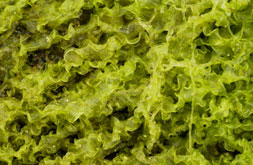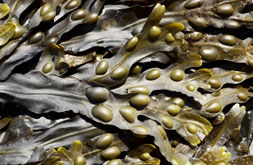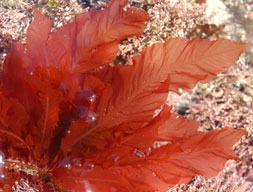This Seaweed Site is a source of general information on all aspects of seaweeds. Seaweeds are marine algae: saltwater-dwelling, simple organisms that fall into the somewhat outmoded, but still useful, category of "plants". Most of them are the green (more than 1800 species), brown (about 2000 species) or red (over 7200 species) kinds, samples of which are each illustrated on this page, and most are attached by holdfasts, which generally just have an anchorage function, although a particularly efficient one.
Colourful Seaweed in Galway Rockpool
This short underwater movie is about a minute long and shows a seaweed-dominated rockpool in the lower intertidal of Galway Bay near Spiddal. The pool is lined with the fronds of Corallina officinalis (pink), with scattered stands of Chondrus crispus (fan-shaped, purple-red, Carrageen Moss) and Cryptopleura ramosa (delicate, crimson-red), occasional plants of Ulva (Sea Lettuce), young plants of Sea-thong (Himanthalia elongata, yellow-brown) forming a tree-like canopy; there are occasional plants of Sea Oak (Halidrys siliquosa brownish-yellow). Oxygen bubbles can be seen escaping as the movie clip progresses.

Do you know any seaweeds?
Most people know two general categories of seaweeds: wracks (species of the brown algal order Fucales such as Fucus) and kelps (species of the brown algal order Laminariales such as Laminaria), and many of you have heard of Carrageen or Irish Moss (usually the red alga, Chondrus crispus) and Dulse or Dillisk (also a red alga, Palmaria palmata). Seaweeds also make up the Sargasso Sea, a large ocean gyre in the western Atlantic where drift plants of several species of the genus Sargassum accumulate. Seaweeds are particularly important ecologically: they dominate the rocky intertidal in most oceans, and in temperate and polar regions cover rock surfaces in the shallow subtidal. Although only penetrating to 8-40 m in most oceans, some are found to depths of 250 m in particularly clear waters (Mediterranean, Caribbean, Brazil). The Giant Kelp (Macrocystis) is one of the largest plants in the world, and in western North America forms an important association with the newly revived Sea Otter.

Yummy Seaweed?
Seaweeds are found throughout the world's oceans and seas and none is known to be poisonous. Many are actually nice to eat and are even considered a great delicacy in many Asian countries. Some recent, healthy recipes can be found here. Seaweeds are used in many maritime regions for industrial applications and as a fertiliser. The major direct use of these plants as food is in Japan, China and Korea, and in the Indian Ocean where seaweed cultivation has become a major coastal industry. The main food species grown by aquaculture in these countries are Nori or Zicai (Porphyra, a red alga), Kombu, Kunbu or Haidai (Laminaria or Saccharina: brown algae) and Wakame (Undaria, also a brown alga). In Japan alone, the total annual production value of nori amounts to more than US$2 billion, one of the most valuable crops produced by aquaculture in the world. In most western countries, seaweed consumption is relatively restricted and there has not been any great pressure to develop mass cultivation techniques. On this site, seaweed aquaculture, particularly nori, a Japanese red seaweed, is described in detail.

Uses of Seaweed
Industrial utilisation of seaweed is mostly centred on the extraction of phycocolloids (marine hydrocolloids), and, to a much lesser extent, certain fine biochemicals. Fermentation and pyrolysis and the use of seaweed as biofuels are not an option on an industrial scale at present, but are possible options for the future, particularly as conventional fossil fuels run out. Seaweeds are being used in cosmetics, and as organic fertilisers. They have the potential to be much more widely used as a source of long- and short-chained biochemicals with medicinal and industrial uses. Marine algae may also be used as energy-collectors and potentially useful substances may be extracted by fermentation and pyrolysis. Seaweed extracts appear in the most unexpected of places; you almost certainly have eaten some sort of seaweed extract in the last 24 hours as many processed foods such as chocolate milk, yoghurts, health drinks, and even some beers and stouts may contain seaweed polysaccharides such as agars, carrageenans and alginates! Seaweed baths have been popular in Ireland and Britain since Edwardian times, and seaweed wraps and treatments have become very poular in the last few years.
Last modified: October 11 2020





